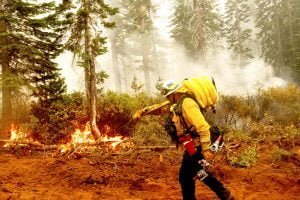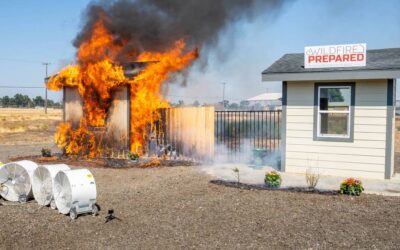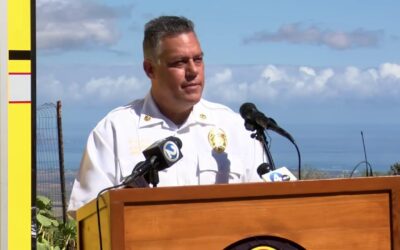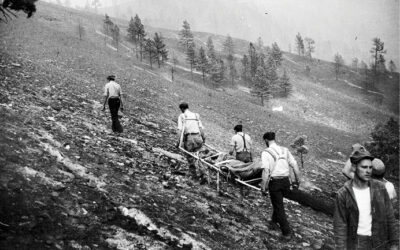
FILE – In this Sept. 14, 2020 file photo Cal Fire Battalion Chief Craig Newell carries a hose while battling the North Complex Fire in Plumas National Forest, Calif. U.S. wildfire managers are considering shifting from seasonal firefighting crews to full-time, year-round crews to deal with what has become a year-round wildfire season and to make wildland firefighting jobs more attractive by increasing pay and benefits. U.S. Forest Service Deputy Chief Christopher French, testifying before the U.S. Senate Committee on Energy and Natural Resources, said Thursday, June 24, 2021 agencies will seek to convert at least 1,000 seasonal wildland firefighters to permanent, full-time, year-round workers. (AP Photo/Noah Berger,File)
By KEITH RIDLER Associated Press
BOISE, Idaho (AP) — U.S. wildfire managers are considering shifting from seasonal to full-time firefighting crews to deal with what has become a year-round wildfire season and making the jobs more attractive by increasing pay and benefits.
There’s a push in Congress to increase firefighter pay and convert at least 1,000 seasonal wildland firefighters to permanent, full-time, year-round workers. U.S. Forest Service Deputy Chief Christopher French, testifying before the U.S. Senate Committee on Energy and Natural Resources Thursday, agreed firefighters are underpaid.
The year-round firefighters could also work removing brush and other hazardous fuels when not battling wildfires. French said the Forest Service treats 3 million acres annually, but to make progress would need to treat two to four times that much in the 193 million acres it manages.
“Without a paradigm shift in the way we treat hazardous fuels on federal and non-federal land, and addressing the impacts of climate change, we will remain in this current wildfire crisis and destruction from wildfires will continue to threaten communities across the West,” he said while testifying on West Virginia Democratic Sen. Joe Manchin’s Energy Infrastructure Act.
The problem has become more challenging in recent decades as more homes are built where urban and wildland areas meet, forcing wildland firefighters into protecting structures.
President Joe Biden recently called for an increase in firefighter pay from $13 an hour.
“That’s a ridiculously low salary to pay federal firefighters,” he said.
Firefighters can often boost pay by working overtime, a regular occurrence on bad fire years.
Increased pay for firefighters was included in infrastructure legislation sponsored by Manchin, the Democratic chair of the energy and natural resources committee and a key swing vote in the evenly-divided Senate.
Manchin was among a bipartisan group of 10 lawmakers who announced a deal Thursday with Biden on a pared-down version of the administration’s plan.
Montana Democratic Sen. Jon Tester, also in the group, said the package would contain money for “wildfire resilience” programs but was unclear on whether raises for firefighters were included.
If it’s not in the bill, Tester said it would be addressed through the agency budget process.
“This is dangerous work, folks need to be paid for it. We’re going to need to hire people to do this work,” he said.
Still, officials at the National Interagency Fire Center in Boise said they face a potential shortage of firefighters this year because the $13 starting wage isn’t enough.
“There’s not technically a shortage of firefighters because we always overprepare,” said Jessica Gardetto, a fire center spokeswoman with the U.S. Bureau of Land Management and a former wildland firefighter. “But it’s a concern right now. We’re seeing people taking jobs at local businesses that pay the same or more than starting fire positions.”
She also said the length of time firefighters spend in the field has been increasing each year. That can be a problem as many seasonal firefighters are college students who need to get back to class.
“In the past we had fire seasons, now we have fire years,” she said.
Officials at the center on Tuesday raised the national preparedness level to 4 on a 1-5 scale, the second earliest dating back to 1990. The primary reason is that much of the U.S. West is immersed in a drought that will likely make putting out fires more challenging and strain firefighting resources throughout the West.
“We don’t know what kind of support we’re going to be able to get from other agencies,” said Sharla Arledge, spokeswoman for the Idaho Department of Lands that is responsible for protecting state and some federal land. “It’s a tinderbox out there.”
About 80% of the state is in a drought.
The nation’s wildland firefighting system is a network of local, state and federal agencies, and in Idaho has grown to include a unique program where ranchers are trained and given equipment to keep wildfires small until help arrives. The vast majority of wildfires are put out within days, but some grow to thousands of acres and draw hundreds and sometimes more than a thousand firefighters.
The concern this year is that calls for help might go unanswered if multiple large fires across the West use all firefighters and equipment.
The record-setting blazes that raged in Oregon, California, Washington and other states in 2020 revealed how stretched thin the ranks of firefighters have become. By September there were so many fires burning across the West that hundreds of requests for help went unfulfilled as agencies scrambled to get enough firefighters, aircraft, engines and support personnel.
Firefighters from across the U.S. and other countries including Canada and Israel were summoned to help fill the personnel shortage.
Idaho officials have also been battling to retain state wildland firefighters that are sometimes poached by the Forest Service, Bureau of Land Management or other federal agencies after gaining some on-the-ground experience. Starting pay for an Idaho wildland firefighter is $12.55 an hour.
As of Thursday, the National Interagency Fire Center said, 52 large fires have burned nearly 900 square miles (2,331 square kilometers). More than 9,000 firefighters are battling the blazes.
About 80% of wildfires annually are started by people, often while enjoying outdoor activities or using fireworks.
___
Associated Press writer Matthew Brown contributed from Billings, Montana.
All contents © copyright 2021 The Associated Press. All rights reserved.




